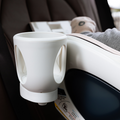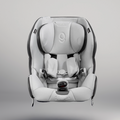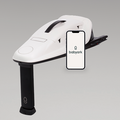In order to be sold, car seats must pass crash test regulations and meet standards dictated by the Federal Motor Vehicle Safety Standards (FMVSS).
So before we dive in, it’s ok to breathe a small sigh of relief.
If you’re using a non-expired car seat correctly, you’re doing right by your children, because it passed required car crash testing.
Transparency of Test Results
As a company founded on combining design and engineering to harness the best of nature and technology, babyark relies on science at its foundation. Part of a scientific approach requires thorough testing, and adaptation. We believe in transparency and research, and want you to have explanations and information at your fingertips. This is why we not only test beyond requirements, we also publish our results.
As in all scientific experiments and situations in life, there are variables outside of our control, and real-life throws variations at us, which can impact results. Even the same test run by a different person, or a different time of day may lead to different outcomes. Also, it is important to remember that for the car seat to work properly, it must be installed correctly!
Read our crash course in crash testing here.
One of the key metrics in car seat crash testing is chest acceleration — and it tells us a lot about how a child’s body would be affected during a crash.
What Is Chest Acceleration?
In a crash, the car stops suddenly — but your child’s body wants to keep moving (an example of Newton’s first law of motion, the law of inertia.)
Chest acceleration measures how quickly the chest moves forward during impact — and it’s a critical predictor of injury. Higher acceleration = more force on the chest = greater risk.
Federal standards cap chest acceleration test results at 60 g (that’s 60 times the force of gravity). Car seat companies are legally required to stay below that threshold.
At babyark, we set a high bar, and aim for low scores - smaller numbers that represent reduced impact on the child in case of a crash.
babyark Chest Acceleration Tests

How babyark Performs in Chest Acceleration
At babyark, we appreciate the importance of federal regulations. But we know that safety, like life, isn’t about one destination. It’s about a continuous journey. So we test, test, and test again. While we strive for a low rating, to us it’s also equally about iterating. And if we don’t have enough proof? We improve.
Across multiple crash configurations, including forward-facing (FF) for 6-year-old crash dummies and rear-facing (RF) for 3-year-olds, babyark consistently delivers good chest acceleration results well within the standard.
Why Chest Acceleration Test Results Matter
Your child’s chest houses critical organs — heart, lungs, and more. Lowering chest acceleration in a crash directly reduces the likelihood of serious internal injury.
babyark’s patented SafeCoil™ and steel structure are engineered to distribute crash forces away from the body — minimizing impact where it matters most.
Wait — What About HIC?
Glad you asked. That’s Head Injury Criteria, another crucial crash test metric. While the federal maximum limit is 1000, babyark consistently scores lower, true to our goals of safety-first engineering.
You can read more about that in our full crash testing deep dive →
Bottom Line
Parents ourselves, we understand the desire to make informed decisions about our purchases for our families, especially when it comes to health. That is why we insist on providing these test results and background for easier self-education, including an overview of not just what they are, but what they mean.
Have more questions about what to look for when purchasing a car seat, and which one is appropriate for your child’s age and measurements?
Check out our blog: Car Seat Safety Regulations, Which Car Seat Do I Need When?




